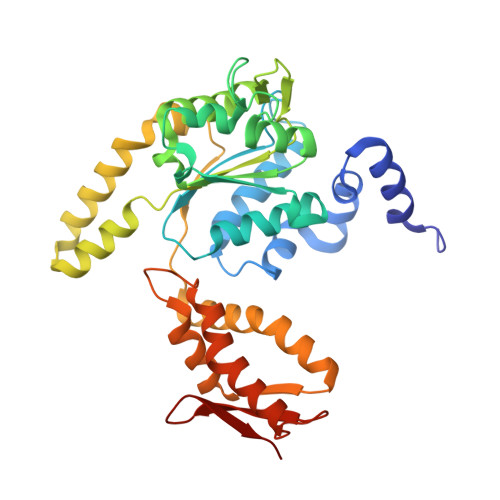Elements in nucleotide sensing and hydrolysis of the AAA+ disaggregation machine ClpB: a structure-based mechanistic dissection of a molecular motor
Zeymer, C., Barends, T.R.M., Werbeck, N.D., Schlichting, I., Reinstein, J.(2014) Acta Crystallogr D Biol Crystallogr 70: 582-595
- PubMed: 24531492
- DOI: https://doi.org/10.1107/S1399004713030629
- Primary Citation of Related Structures:
4LJ4, 4LJ5, 4LJ6, 4LJ7, 4LJ8, 4LJ9, 4LJA - PubMed Abstract:
ATPases of the AAA+ superfamily are large oligomeric molecular machines that remodel their substrates by converting the energy from ATP hydrolysis into mechanical force. This study focuses on the molecular chaperone ClpB, the bacterial homologue of Hsp104, which reactivates aggregated proteins under cellular stress conditions. Based on high-resolution crystal structures in different nucleotide states, mutational analysis and nucleotide-binding kinetics experiments, the ATPase cycle of the C-terminal nucleotide-binding domain (NBD2), one of the motor subunits of this AAA+ disaggregation machine, is dissected mechanistically. The results provide insights into nucleotide sensing, explaining how the conserved sensor 2 motif contributes to the discrimination between ADP and ATP binding. Furthermore, the role of a conserved active-site arginine (Arg621), which controls binding of the essential Mg2+ ion, is described. Finally, a hypothesis is presented as to how the ATPase activity is regulated by a conformational switch that involves the essential Walker A lysine. In the proposed model, an unusual side-chain conformation of this highly conserved residue stabilizes a catalytically inactive state, thereby avoiding unnecessary ATP hydrolysis.
- Department of Biomolecular Mechanisms, Max Planck Institute for Medical Research, Jahnstrasse 29, 69120 Heidelberg, Germany.
Organizational Affiliation:


















